
A Kreis (pl. Kreise) or 'Circle' was an administrative division of the Habsburg monarchy and Austrian Empire between 1748 and 1867.
History
Creation
After the Prussian annexation of the bulk of Silesia following the First and Second Silesian Wars, it became apparent that Frederick II's administrative structures allowed him to take much higher tax revenues from the area. Therefore, in the years following end of the War of the Austrian Succession in 1748, Maria Theresa and Joseph II enacted several administrative reforms with Prussia as a model, and the old territorial divisions were converted into new Kreise. These reforms were carried out by Maria Theresa's advisor Count Friedrich Wilhelm von Haugwitz and continued under chancellor Prince Wenzel Anton von Kaunitz-Rietberg from 1760. The bureaucratisation in the form of Kreisämtern ('circle offices', SG Kreisamt) lessened the influence of the estates by essentially separating them from the administration of the realms.
The origin of the Kreis as a unit of administration lay in Bohemia, where Kraje (Kreise in German) had existed as territorial units since the 14th century (see Bohemia § Historical administrative divisions). Through the reform the system was further developed and applied to the Habsburgs' other realms (other than Hungary). In the Archduchy of Austria and Duchy of Styria the old quarters (German: Viertel) served as a basis for the new Kreise (Waldviertel, Mostviertel, Industrieviertel and Weinviertel in Lower Austria; Innviertel, Hausruckviertel, Mühlviertel, and Traunviertel in Upper Austria; Quarter division of Styria 1462).
The Hungarian counterparts were the Comitatus (German: Gespanschaften or Komitate, formerly spelled Comitate; Hungarian: Vármegyék), which had existed for much longer and were dominated by the nobility.
In Lombardy–Venetia (1815–1859/66) there were "delegations",[1] which gave rise to the later Provinces.
After 1848
The Amtsbezirke ('office districts'), or more precisely the Bezirksämter ('district offices'), created in the reforms which followed the Revolutions of 1848 (specifically those of 1849[2] and 1853[3]), largely took over the responsibilities of the Kreisämter. These were proposed as early as 1849 by Interior Minister Alexander von Bach as part of a necessary reform to the administrative apparatus to deal with the increase in the number citizens interacting with the offices following the final abolition of serfdom in 1848. The Kreis administrations were thereby subdivided into subordinate Amtsbezirke. Some smaller Kreise were abolished or merged. The Kreis system was also expanded to the Voivodeship of Serbia and Banat of Temeschwar[3][4] (formerly part of southern Hungary) and the Grand Principality of Transylvania[5] in the course of these reforms.
The statutory cities were also excluded from Kreis administration, much like they are excluded from the modern districts (Bezirke).
Abolition
With the creation of the political districts (Bezirke) in 1868, which go back to the December Constitution of 1867,[6] the Kreis divisions were abolished and replaced with much more finely divided Bezirk divisions; however, the newly created district commissions (Bezirkshauptmannschaften) were strongly influenced by the former Kreis administrations.
Organisation
With the Kreisämtern there was for the first time a level of administration between the manors and free cities and the Imperial Court (in the crown lands the gubernatorial administration). At the head of every Kreis was a Kreishauptmann (roughly 'circle/district captain/head'; see Hauptmann), whose officials were entrusted with clearly defined tasks, which significantly disempowered the estates in financial matters. The Kreisämter were the lowest level of political administration. This brought together direct oversight of taxation, as well as the conscription and recruitment system, the supervision of schools and poorhouses, the supervision of the individual municipalities and the protection of the peasants before the manor lords. The captains were obliged to travel to the Kreise at least once per year or allow the inspectors to visit. For this the captains received a state salary, but were not allowed to hold any other lordly or stately offices and were bound to their instructions.
The Kreisämtern were subordinate to the Gubernia (the administrative bodies of the crown lands, roughly governorates).
Legacy
Despite numerous reforms, the borders of the Kreise are still roughly visible in the 39 Austrian electoral districts. Also the divisions (Sprengel) of the district courts (Kreisgerichte; now regional courts – Landesgerichte) are essentially equivalent to those of the former Kreisämter. The 35 NUTS 3 regions are loosely aligned with the former Kreis divisions.
List of Kreise
The following is a list of the Kreise and statutory cities in the non-Hungarian lands of the Austrian Empire (Cisleithania in later terminology) c. 1854;[7] pre-1848 Kreise[1] are also listed where applicable.
Lands of the Bohemian Crown
Kingdom of Bohemia
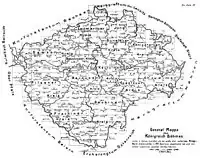
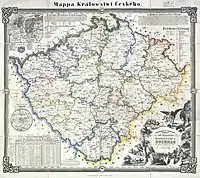

| Name | Seat/administrative centre | Notes | |
|---|---|---|---|
| German | Czech | ||
| Prag | Praha | itself (Prague) | Statutory city |
| Kreis Prag, Prager Kreis | Pražský kraj | Prague | formed in 1849 from Rakonitzer Kreis and parts of Berauner, Bunzlauer and Kaurimer Kreise |
| Kreis Beraun or Berauner Kreis | Berounský kraj | Beroun; Kreisamt in Prague[1] | abolished in 1849; divided between the Prager and Taborer Kreise |
| Kreis Kaurim/Kaurzim or Kaur(z)imer Kreis | Kouřimský kraj | Kouřim; Kreisamt in Prague[1] | abolished in 1849; mostly divided between the Prager and Taborer Kreise, with some areas passing to the Caslauer Kreis |
| Kreis Rakonitz or Rakonitzer Kreis | Rakovnický kraj | Rakonitz/Rakovník | abolished in 1849 |
| Kreis Budweis or Budweiser Kreis | Budějovický kraj | Budweis/České Budějovice | |
| Kreis Bunzlau or Bunzlauer Kreis | Boleslavský kraj | Jung-Bunzlau/Mladá Boleslav |
|
| Kreis Chrudim or Chrudimer Kreis | Chrudimský kraj | Chrudim | |
| Kreis Časlau, Kreis Czaslau or Časlauer/Czaslauer Kreis | Čáslavský kraj | Czaslau/Čáslav | |
| Kreis Eger or Egerer Kreis | Chebský kraj | Eger/Cheb | established in 1849 from Elbogener Kreis and part of Pilsner Kreis |
| Kreis Elbogen or Elbogner Kreis | Loketský kraj | Elbogen/Loket | became Egerer Kreis in 1849 |
| Kreis Gitschin, Gitschiner Kreis or Jičiner Kreis | Jičínský kraj | Gitschin/Jičín | established in 1849 from Bidschower Kreis |
| Kreis Bidschow or Bidschower Kreis | Bydžovský kraj | Bidschow/Nový Bydžov | became Gitschiner Kreis in 1849 |
| Kreis Königgrätz or Königgrätzer Kreis | Hradecký kraj | Königgrätz/Hradec Králové | |
| Kreis Leitmeritz or Leitmeritzer Kreis | Litoměřický kraj | Litoměřice | Kreisgerichte ('circle/district courts') 1854: Leitmeritz, Böhmisch-Leipa[8] |
| Kreis Pilsen or Pilsner Kreis | Plzeňský kraj | Plzeň | in 1849 absorbed Klattauer Kreis |
| Kreis Pisek or Piseker Kreis | Písek | established in 1849 from Prachiner Kreis | |
| Kreis Prachin or Prachiner Kreis | Prácheňský kraj or Prácheňsko | Prácheň Castle | became Piseker Kreis in 1849 |
| Kreis Saaz or Saazer Kreis | Žatecký kraj | Saaz/Žatec | |
| Kreis Tábor or Tabórer Kreis | Táborský kraj | Tábor | |
| Kreis Klattau or Klattauer Kreis | Klatovský kraj | Klattau/Klatovy | abolished in 1849 (absorbed into Pilsner Kreis) |
1849–54
In the 1849 administrative reforms which followed the Revolutions of 1848 and introduced the first political districts (Bezirkshaupmannschaften), the Kreise of Bohemia were reduced to seven:[9]
- City of Prague
- Prager Kreis – 8 political districts:
- Smichow
- Eule
- Carolinenthal
- Rakonitz
- Schlan
- Melnik
- Przibram
- Horzowic
- Budweiser Kreis – 9 political districts:
- Budweis
- Krumau
- Kaplitz
- Neuhaus
- Tabor
- Mühlhausen
- Pilgram
- Beneschau
- Wotitz
- Pardubitzer Kreis – 11 political districts:
- Pardubitz
- Kolin
- Schwarz-Kosteletz
- Kuttenberg
- Ledetsch
- Deutsch-Brod
- Chotieborg
- Chrudim
- Hohenmauth
- Leitomischl
- Landskron
- Gitschiner Kreis – 16 political districts:
- Gitschin
- Königgrätz
- Königinhof
- Trautenau
- Braunau
- Reichenau
- Senftenberg
- Neustadt
- Horzic
- Hohenelbe
- Podiebrad
- Neubidschow
- Turnau
- Semil
- Jungbunzlau
- Nimburg
- Böhmisch-Leippaer Kreis – 10 political districts:
- Böhmisch-Leippa
- Reichenberg
- Friedland
- Gabel
- Tetschen
- Außig
- Schlukenau
- Rumburg
- Dauba
- Leitmeritz
- Egerer Kreis – 12 political districts:
- Eger
- Falkenau
- Plan
- Tachau
- Carlsbad
- Luditz
- Graßlitz
- Joachimsthal
- Saaz
- Kaaden
- Brüx
- Teplitz
- Pilsner Kreis – 13 political districts:
- Pilsen
- Rokitzan
- Kralowitz
- Klattau
- Przestiz
- Bischofteinitz
- Tauß
- Schüttenhofen
- Winterberg
- Prachatitz
- Pisek
- Strakinitz
- Brzeznitz
These Kreise lasted until the reforms of 1853/54.[8]
Margraviate of Moravia
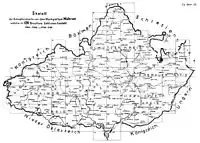
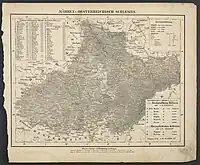
Until 1848 part of the joint Gubernium of Moravia and Silesia (Gouvernment Mähren und Schlesien or Mährischschlesisches Landesgubernium).[1]
- City of Brünn (Brno)[10]
- Kreis Brünn or Brünner Kreis
- Kreis Iglau or Iglauer Kreis (Jihlava)
- Kreis Neutitschein (Nový Jičín); until 1848: Kreis Prerau or Prerauer Kreis (Přerov)
- Kreis Olmütz or Olmützer Kreis (Olomouc)
- City of Olmütz (Stadtbezirk subordinate to Kreis Olmütz)[10]
- Kreis Hradisch or Hradischer Kreis (Uherské Hradiště)
- Kreis Znaim or Znaimer Kreis (Znojmo)
1849–54
In the 1849 administrative reforms which followed the Revolutions of 1848 and introduced the first political districts (Bezirkshaupmannschaften), the Kreise of Moravia were reduced to two:[11]
- Brünner Kreis (Brněnský kraj) – 12 political districts:
- Olmützer Kreis (Olomoucký kraj) – 13 political districts:
- Olmütz
- Sternberg
- Schönberg
- Hohenstadt
- Littau
- Neutitschein
- Weißkirchen
- Wistek
- Wallachisch-Meseritsch
- Hradisch
- Kremsier
- Holleschau
- Ungarischbrod [sic]
The pre-revolution Kreise were restored, with minor changes, in the reforms of 1853/54.[10]
Austrian Silesia
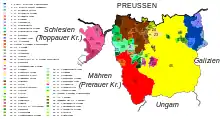
Formally the Duchy of Upper and Lower Silesia (Herzogtum Ober- und Niederschlesien). Until 1848 part of the joint Gubernium of Moravia and Silesia (Gouvernment Mähren und Schlesien or Mährischschlesisches Landesgubernium).[1] Although administratively separate Silesia was judicially subordinate to Brünn (Moravia) thereafter.[12] Austrian Silesia had no Kreise after the 1849[11] or 1853 reforms,[3] but the separate Kreisgerichte remained for judicial matters.[12]
- City of Troppau (Opava)
- Kreis Troppau or Troppauer Kreis
- Kreis Teschen or Teschener Kreis (Těšín, Polish: Cieszyn; similar to Cieszyn Silesia but with an exclave on the far side of the Oder)
Archduchy of Austria

Austria below the Enns
Corresponds with modern Lower Austria.
- from 1850: the city of Vienna (Wien)[13] (traditionally part of the Kreis Unter dem Wienerwald[1]: 317 )
- Kreis Ober (dem) Manhartsberg ('Circle above the Manhartsberg'); seat at Krems.[1]: 317 [14]
- Kreis Ober (dem) Wienerwald ('Circle above the Vienna Woods'), seat at Sankt Pölten.[1]: 317 [14]
- Kreis Unter (dem) Manhartsberg ('Circle below the Manhartsberg'); seat at Korneuburg.[1]: 317 [14]
- Kreis Unter (dem) Wienerwald ('Circle below the Vienna Woods'); seat at Wiener Neustadt from 1853;[14] c. 1842 administered from Vienna, Baden and Wiener Neustadt;[1]: 317 earlier Traiskirchen.[1]: 317
- from 1866: the city of Wiener Neustadt[15]
Austria above the Enns
Corresponds with modern Upper Austria. The Kreise in Austria above the Enns were from 1749 subdivided into district commissions and regional courts.[16]
- from 1850: the city of Linz[17] (previously part of the Mühlkreis;[1]: 317 part of the Hausruckkreis until the early 19th century)
- Hausruckkreis; 1810–16 partially annexed to Bavarian Unterdonaukreis.[note 1] Seat at Wels.[1]: 317 [18]
- after 1779: Innkreis; annexed from the Electorate of Bavaria by the 1779 Treaty of Teschen; 1810–16 to Bavarian Unterdonaukreis.[note 1] Seat at Ried.[1]: 317 [18]
- Mühlkreis; seat at Linz[1]: 317 [18] (from the early 19th century). Comprised the areas north of the Danube and, from the early 19th century, the immediate area around Linz. Initially divided into Upper and Lower sections, corresponding to the pre-1779 Mühlviertel (upper, western) and Machlandviertel/Schwarzviertel (lower, eastern).
- from 1867: the city of Steyr[19] (traditionally part of the Traunkreis[1]: 317 )
- Traunkreis; seat at Steyer.[1]: 317 [18] Traditionally bounded by the Traun river. In the early 19th century expanded to include part of the western Traun basin, roughly up to the boundaries of the modern Gmunden District (excluding St. Wolfgang im Salzkammergut). Upon the re-establishment of the Kreise in 1853 roughly the western third of the previous Traunkreis, including Ischl, Gmunden and Hallstatt (roughly corresponding to the modern Gmunden District and some parts of the Wels-Land District south of the Traun), became part of the Hausruckkreis.[18]
- 1816–1849: Salzburgkreis or Salzachkreis (see below); the Electorate of Salzburg was mediatised to Austria in the 1805 Peace of Pressburg; 1810–16 to Bavarian Salzachkreis;[note 1] integrated into Austria above the Enns as a Kreis in 1816. Seat at Salzburg.
Duchy of Salzburg (from 1849)
Formerly the Salzburgkreis or Salzachkreis of Austria above the Enns, the Duchy of Salzburg became a crown land in its own right (with a single Kreis) on 26 June 1849[20] (formally constituted 30 December[21]). The Duchy of Salzburg had no Kreise after 1853.[3]
- City of Salzburg
- Salzburgkreis or Salzachkreis (1849[20] to 1853[3])
Duchy of Styria
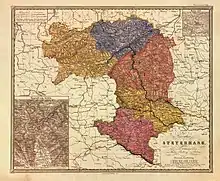
The Duchy of Styria (German: Herzogtum Steiermark, contemporary spelling Herzogthum Steyermark), although administered as a single gubernium/Gouvernement, was divided into upper and lower parts – Obersteiermark (Obere-Steyermark) and Untersteiermark (Untere-Steyermark).[1]: 318 The upper part, which comprised the Judenburger and Brucker Kreise,[1]: 318 corresponds with the modern Austrian use of the term Upper Styria, i.e. the modern districts of Bruck-Mürzzuschlag, Leoben, Liezen, Murau and Murtal in the north-west of the modern Austrian state of Styria; from 1848 it was synonymous with the now-expanded Brucker Kreis. The lower part, which comprised the Grazer, Marburger and Cillier Kreise,[1]: 318 included all of Slovene Styria and the modern Austrian Central Styria.
- City of Graz (from 1850)[22]
- Kreis Graz or Grazer Kreis (also spelled Gratz(er), Grätz(er))
- Kreis Bruck or Brucker Kreis (Bruck an der Mur); Kreisgericht ('circle/district court') in 1854 in Leoben.[23]
- Kreis Marburg or Marburger Kreis (Marburg an der Drau, Slovene: Maribor); in 1848 northwestern parts merged into Kreis Graz; Kreisgericht ('circle/district court') in 1854 in Cilli.[23]
- until 1848: Kreis Cilli or Cillier Kreis (Celje; merged into Kreis Marburg 1848; also spelled Zilli(er))
- until 1848: Kreis Judenburg or Judenburger Kreis (Judenburg; merged into Kreis Bruck 1848)
Kingdom of Illyria (until 1849)
The Kingdom of Illyria was a crown land formed as a successor to the Napoleonic Illyrian Provinces[note 2] after the 1815 Congress of Vienna returned its territory to Austria. It was divided into two Gubernia: Gubernium Laibach[note 3] and Gubernium Triest.[note 4] It was disbanded in 1849 and replaced with the separate Duchy of Carinthia, Duchy of Carniola and Austrian Littoral crown lands. The Kreise listed below are grouped by these post-1849 crown lands; internally within the Kingdom they were grouped as such,[1] and the duchies and subdivisions of the Littoral correspond with Habsburg states which existed before the 1809 Treaty of Schönbrunn by which they were annexed by Napoleon.
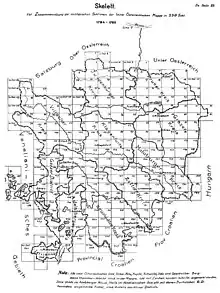
Until 1809 the area (excluding those parts of Croatia and the Military Frontier which were Illyrian until the 1820s) was organised as part of Inner Austria, an informal region which comprised the Duchies of Styria, Carinthia and Carniola, the County of Gorizia and Gradisca, the March/Margraviate of Istria and the Free City of Trieste. During this period the Habsburg March of Istria only included a small interior part of the peninsula centred on Mitterburg (Pazin, Pisino) and was administered from Carniola; the north-eastern mostly inland part of the later Istrian Kreis, as well as part of the eastern coast of the peninsula and a northern coastal exclave around Duino-Aurisina were part of the Carniolan Adelsberger Kreis. The Republic of Venice held most of the peninsula itself, including all of the western coast and around half of the eastern coast, as well as the islands in the Kvarner Gulf including Krk and Cres; the Venetian territories were annexed by Austria (as the Venetian Province) in the 1797 Treaty of Campo Formio, but lost again to the Napoleonic Kingdom of Italy in the 1805 Peace of Pressburg. The mercury-mining area around Idrija had a special status apart from the Carniolan Kreise. The Princely County of Gorizia and Gradisca included several exclaves in Venetian territory and within the Carniolan Adelsberger Kreis; by the 1805 Peace of Pressburg and 1807 Treaty of Fontainebleau, the parts of the county west of the Soča/Isonzo were ceded to the Napoleonic Kingdom of Italy.
Duchy of Carinthia
The Duchy of Carinthia (Herzogt(h)um Kärnten) was 1815–49 part of Gubernium Laibach of the Kingdom of Illyria; separate crown land thereafter. Carinthia had no Kreise after 1853.[3]
- from 1850: City of Klagenfurt
- Klagenfurter Kreis or Kreis Klagenfurt (comprised Lower Carinthia until 1848)
- until 1848: Villacher Kreis or Kreis Villach (Villach; Upper Carinthia)
Duchy of Carniola

The Duchy of Carniola (Herzogt(h)um Krain) was 1815–49 part of Gubernium Laibach of the Kingdom of Illyria. Carniola had no Kreise after 1853.[3]
- from 1850: City of Laibach (Ljubljana)
- Kreis Laibach or Laibacher Kreis (comprising Upper Carniola until 1848; all of Carniola thereafter. Sometimes spelled Laybach.)
- until 1848: Kreis Adelsberg or Adelsberger Kreis (Postojna; Inner Carniola).
- until 1848: Kreis Neustädtl or Neustädt(l)er Kreis (Novo mesto; Lower Carniola)
Littoral

Formally the Princely County of Gorizia and Gradisca, the Margraviate of Istria and the City of Triest with its Territory (die gefürstete Grafschaft Görz und Gradiska, die Markgrafschaft Istrien und die Stadt Triest mit ihr Gebiet). 1815–49 Gubernium Triest of the Kingdom of Illyria; separate crown land thereafter.
- City of Triest (Italian: Trieste, Slovene: Trst)
- City of Görz (Gorizia, Gorica)
- Kreis Görz; also Görzer Kreis, österreichisches Friaul[1] (Austrian Friuli)
- Kreis Istrien (Istria, Istra); also Istrier Kreis, Mitterburger Kreis.[1] Seat in Mitterburg (Pazin, Pisino); Kreisgericht in Rovigno.[24]
- City of Rovigno (Croatian: Rovinj)
Judicially the Gorizian districts of Comen (Komen) and Sessana (Sežana) and the Istrian districts of Capo d'Istria (Koper, Kopar), Pirano (Piran), Castel-Nuovo (Podgrad) and Volosca (Volosko) were subordinate to the Landesgericht in Trieste (c. 1853).[24]
Other
In addition to the Kreise of Carinthia, Carniola and the Littoral listed above, until the 1820s the Kingdom of Illyria also included the former Croatie civile province of the Napoleonic Illyrian Provinces. This territory was transferred to the re-established Kingdom of Croatia, except for Fiume (Rijeka), which returned to its previous status as a Corpus separatum under Hungary. This was organised into:
- Kreis Karlstadt/Karlstädter Kreis (Karlovac)
- Kreis Fiume/Fiumaner Kreis (Fiume/Rijeka, which also included the eastern parts of the Istrian peninsula which would later become part of Kreis Istrien
Like the Littoral, these belonged to Gubernium Triest. During this time the remainder of Istria and the southern part of what was later Görz, including all of its coastline (much of which had been part of the Carniolan Adelsberger Kreis until 1809), was organised as the Triester Kreis, which was distinct from the city of Triest.
Tyrol and Vorarlberg

Formally the Princely County of Tyrol with Vorarlberg (die gefürstete Grafschaft Tirol mit Vorarlberg)[25] until 1861.
- City of Innsbruck[25]
- Kreis Innsbruck. Broadly coextensive with modern North Tyrol. Formed in 1849 from:[26]
- City of Bozen
- Kreis Brixen, centred on Bozen. Broadly coextensive with modern South and East Tyrol.[note 7] Formed in 1849 from:[26]
- Kreis Pustertal[note 5] or Brunecker Kreis
- Etschkreis or Bozener Kreis
- The district of Glurns, formerly belonging to Kreis Oberinntal
- until 1861: Kreis Bregenz, Bregenzer Kreis, Kreis Vorarlberg or Vorarlberger Kreis; detached as a separate crown land – Land Vorarlberg – in the 1861 February Patent.[27]
- City of Rovereto
- City of Trient (Italian: Trento)
- Kreis Trient. After 1849 it was broadly coextensive with modern Trentino.[note 6]
- until 1849: Kreis Rovereto (or Roveredo); merged into Kreis Trient 1849.[26] A Kreisgericht of Roveredo covering the former territory of Kreis Roveredo (the Bezirke of Ala, Arco, Condino, Mori, Nogaredo, Riva, Roveredo, Stenico and Tione) existed within Kreis Trient as of 1854.[25]
Galicia and Lodomeria; Bukovina
Formally the Kingdom of Galicia and Lodomeria with the Grand Duchy of Kraków (after 1846) and the Duchies of Auschwitz and Zator (Königreich Galizien und Lodomerien mit dem Großherzogt(h)um Krakau und den Herzogt(h)ümern Auschwitz und Zator). The Grand Duchy of Kraków, which was annexed in 1846 (previously the Free City of Cracow) corresponded with the Krakauer Kreis; Auschwitz and Zator had no administrative status, with both forming part of the Wadowicer Kreis, although nominally they were part of the German Confederation while the rest was not.
- City of Lemberg (Ukrainian: Львів, romanized: Lviv, Polish: Lwów)
- Kreis Lemberg or Lemberger Kreis
- Kreis Bochnia or Bochnier Kreis; merged with Kreis Krakau 1860[28]
- Kreis Brzeżan or Brzeżaner Kreis (Berezhany)
- Kreis Bukowina, Bukowiner Kreis, Czernowitzer Kreis or Kreis Czernowitz; military district before 1786; separate crown land – the Duchy of Bukovina – from 1849;[29] the Duchy had no Kreise from 1853;[3] reincorporated (as Kreis Czernowitz) into Galicia and Lodomeria in 1860;[28] re-separated in the 1861 February Patent.[27]
- City of Czernowitz (Ukrainian: Чернівці́, romanized: Chernivtsi Romanian: Cernăuți); part of Bukovina when a separate crown land.
- Kreis Czortków or Czortówer Kreis (Chortkiv) – former Russian part of Kreis Zaleszczyki restored to Austria by the Congress of Vienna 1815.
- Kreis Jasło or Jasłoer Kreis; disbanded and split between the Sandecer (Bezirke Gorlice and Biecz), Tarnower (Bezirke Brzostek, Frysztak and Jasło), Rzeszower (Bezirk Strzyżów) and Sanoker (Bezirke Krosno, Żmigród and Dukla) Kreise in 1860[28]
- Kreis Kolomea or Kolomeaer Kreis (Kolomyja) – created in 1809 out of the rump of Kreis Zaleszczyki and part of Kreis Stanislau.
- City of Krakau (Polish: Kraków)
- after 1846: Kreis Krakau (see Grand Duchy of Kraków)
- Kreis Przemyśl or Przemyśler Kreis (Przemyśl; Ukrainian: Перемишль, romanized: Peremyshl, German: Premissel)
- Kreis Rzeszów or Rzeszówer Kreis (Rzeszów)
- Kreis Sambor or Samborer Kreis (Sambir)
- Kreis Sandec or Sandecer Kreis (Neu Sandec; Polish: Nowy Sącz)
- Kreis Sanok or Sanoker Kreis (Sanok)
- Kreis Stanislau or Kreis Stanisławów, Stanislauer Kreis, Stanisławower Kreis (Stanisławów, contemporary Ukrainian: Станісла́вів Stanislaviv; modern Івано-Франківськ Ivano-Frankivsk)
- Kreis Stryj or Kreis Stryi, Stryer Kreis (Stryi)
- Kreis Tarnopol or Tarnopoler Kreis (Tarnopol, Ukrainian: Тернопіль, romanized: Ternopil). Ceded to Russia in the 1809 Treaty of Schönbrunn – Tarnopolsky Krai. Restored to Austria by the Congress of Vienna 1815.
- Kreis Tarnów or Tarnówer Kreis (Tarnów)
- Kreis Wadowice or Wadowicer Kreis (Wadowice); Myslenicer Kreis until 1819; merged with Kreis Krakau 1860[28]
- until 1809: Kreis Zamość; ceded to Duchy of Warsaw in the 1809 Treaty of Schönbrunn (to Congress Poland after 1815)
- Kreis Złoczów or Złozówer Kreis (Złoczów; German: Solotschiw, Ukrainian: Золочів, romanized: Zolochiv)
- Kreis Żółkiew or Zołkiewer Kreis (Żółkiew; German: Schowkwa, Ukrainian: Жовква, romanized: Zhovkva)
- until 1809: Kreis Zaleszczyki or Zalestschyker Kreis. Bulk of the Kreis (the part bounded by the Dniester and Strypa rivers) ceded to Russia in the 1809 Treaty of Schönbrunn – Tarnopolsky Krai; remainder becomes part of Kreis Kolomea. Restored to Austria by the Congress of Vienna 1815 as Kreis Czortków.
Regierungsbezirke (1850–53)
In 1850 Galicia and Lodomeria was divided into three Regierungsbezirke ('government districts'), named after their capitals: Lemberg, Krakau and Stanislau. The Kreise were abolished and replaced with political districts (Bezirkshauptmannschaften).[30]
Verwaltungsbebiete (1854–60)
The 1850 changes to the administrative structure of the empire were reversed in Bach's January 1853 reforms, although the precise divisions remained to be determined.[3] In April 1854 Galicia and Lodomeria was divided into two Verwaltungsgebiete (lit. 'administrative regions/territories') and its Kreise formally restored:[31]
- Verwaltungsgebiet Lemberg, containing the 12 eastern Kreise:
- Lemberg
- Zołkiew
- Przemyśl
- Sanok
- Złoczow
- Brzezan
- Stryi
- Sambor
- Tarnopol
- Czortkow
- Kolomea
- Stanislau
- Verwaltungsgebiet Krakau, containing the 7 western Kreise:
- Krakau
- Wadowice
- Sandec
- Jasło
- Rzeszow
- Tarnow
- Bochnia
The cities of Lemberg and Krakau remained directly subordinate to the crown land.[31] Bukovina was not part of Galicia and Lodomeria at this time.[3]
A list detailing the Bezirke of each Kreis from 1853 can be found at Subdivisions of the Kingdom of Galicia and Lodomeria § List of Kreise and Bezirke from 1854
In 1860 Verwaltungsgebiet Krakau and Bukovina were dissolved and re-subordinated to Lemberg.[28]
West or New Galicia (1795–1803/09)



West or New Galicia (Westgalizien/Neugalizien) comprised the Habsburgs' gains in the Third Partition of Poland in 1795. The first-partition Myslenicer, Sandecer and Bochnier Kreise were also attached to it. It was incorporated into Galicia and Lodomeria 1803–09 as a separate gubernium. Other than the first-partition Kreise it was ceded to the Duchy of Warsaw in 1809 by the Treaty of Schönbrunn (Congress Poland and Free City of Cracow after 1815).
- Krakauer Kreis (Kraków)
- Myslenicer Kreis (first partition)
- Sandecer Kreis (first partition)
- Bochnier Kreis (first partition)
- Slomniker Kreis
- Stopnicer Kreis
- Opatower Kreis (before 1789: Kreis Sandomierz)
- Konskier Kreis (Końskie)
- Radomer Kreis (Radom)
- Jozefower Kreis (Józefów)
- Lubliner Kreis (Lublin)
- Chełmer Kreis or Chelmer Kreis (Chełm)
- Bialer Kreis (Biała Podlaska)
- Siedlcer Kreis (Siedlce)
- Wiazowner Kreis or Wiazownaer Kreis (earlier: Kreis Mińsk)
Kingdom of Dalmatia
Other crown lands
In the years following the revolutions of 1848 the Kreis system was extended to some additional crown lands:
Voivodeship of Serbia and Banat of Temeschwar
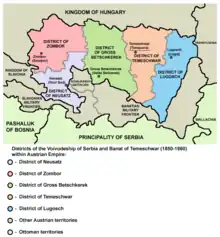
The Voivodeship of Serbia and Banat of Temeschwar, a short-lived crown land which existed 1849–60, was formally divided into Kreise in 1854.[4] Before the revolutions of 1848 it had been the Bács-Bodrog, Torontál, Temes, and Krassó Counties of Hungary and part of the Syrmia County of Slavonia
- Kreis Temesvár (Temesvár, German: Temeswar (or Temeschwar), Romanian: Timișoara, Serbian: Темишвар Temišvar). Corresponded with Temes County.
- Kreis Lugos ((Deutsch-)Lugos, modern German: Lugosch; Romanian: Lugoj, Serbian: Лугош Lugoš). Corresponded with Krassó County.
- Kreis Gross-Becskerek (modern German: Großbetschkerek; Hungarian: Nagybecskerek, Romanian: Becicherecul, Serbian: Велики Бечкерек Veliki Bečkerek; modern Serbian: Зрењанин Zrenjanin). Corresponded with Torontál County.
- Kreis Zombor (Zombor, Serbian: Сомбор Sombor). Corresponded with the northern parts of Bács-Bodrog County.
- Kreis Neusatz (Neusatz, Hungarian: Újvidék, Serbian: Нови Сад Novi Sad). Corresponded with the southern parts of Bács-Bodrog County and eastern parts of Syrmia County.
Grand Principality of Transylvania
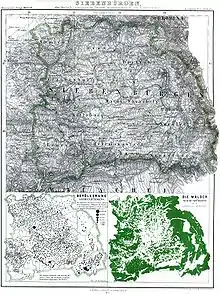
- 1851–54 (5 Kreise or Verwaltungsgebiete):[5]
- Kreis Herrmannstadt or Herrmannstädter Kreis (the "Sachsenland"; Romanian: Sibiu, Hungarian: Nagyszeben)
- Kreis Karlsburg or Karlsburger Kreis (Romanian: Alba Iulia, Hungarian: Gyulafehérvár)
- Kreis Klausenburg or Klausenburger Kreis (Romanian: Cluj-Napoca, Hungarian: Kolozsvár)
- Kreis Dées or Déeser Kreis (Romanian: Dej; modern Hungarian: Dés; German: Desch, Burglos)
- Kreis Maros-Vásárhely (modern Hungarian: Marosvásárhely, Romanian: Târgu Mureș, German: Neumarkt am Mieresch)
- 1854 (10 Kreise):[32]
- Kreis Herrmannstadt
- Kreis Kronstadt (Romanian: Brașov, Hungarian: Brassó)
- Kreis Udvarhely (German: Odorhellen, Romanian: Odorheiu Secuiesc, Hungarian: (Székely)udvarhely)
- Kreis Maros-Vásárhely
- Kreis Bistritz (Romanian: Bistrița, Hungarian: Beszterce)
- Kreis Déés
- Kreis Szilágy-Somlyó (German: Schomlenmarkt, Romanian: Șimleu Silvaniei, modern Hungarian: Szilágysomlyó)
- Kreis Klausenburg
- Kreis Karlsburg
- Kreis Broos (Romanian: Orăștie, Hungarian: Szászváros)
The traditional subdivisions of Transylvania (and the Partium) were restored in the 1860s.
Notes
- 1 2 3 By the 1809 Treaty of Schönbrunn the Kingdom of Bavaria annexed various territories from Austria in 1810. These were returned in the 1816 Treaty of Munich.
- ↑ The Illyrian provinces contained some territory – eastern Tyrol around Lienz – which was not part of the Kingdom of Illyria. Likewise, eastern/"Lower" Carinthia was part of the Kingdom of Illyria but never part of the Illyrian Provinces, having remained Austrian in 1809.
- ↑ Gubernium Laibach was also known as Upper Illyria (Ober-Illyrien)[1]
- ↑ Gubernium Triest was also known as Lower Illyria (Unter-Illyrien) or as the Littoral (Küstenland),[1] a name also used for the post-1849 crown land.
- 1 2 3 4 In contemporary German the word Tal, meaning valley, was spelled Thal, as were the names of Kreise which included it, i.e.: Oberinnthal or Ober-Innthal; Unterinnthal, Unter-Innthal or Unter-Inn und Wippthal; Pusterthal.
- 1 2 In addition to the territory of modern Trentino, post-1849 Kreis Trient also included what is now:
- Valvestino and Magasa in Brescia
- Pedemonte in Vicenza
- Unsere Liebe Frau im Walde-St. Felix, Laurein/Lauregno and Proveis/Proves in South Tyrol.
- ↑ In addition to the territory of modern South and East Tyrol, Kreis Brixen also included Livinallongo del Col di Lana, Colle Santa Lucia and Cortina d'Ampezzo, which are now part of Belluno. It also excluded Graun im Vinschgau (which was part of Kreis Innsbruck), and a few municipalities which were part of Kreis Trient.[note 6]
References
- 1 2 3 4 5 6 7 8 9 10 11 12 13 14 15 16 17 18 19 20 21 22 23 24 25 26 A. Balbis (1842), Allgemeine Erdbeschreibung oder Hausbuch des geographischen Wissens., Pest
- ↑ Gesetz vom 26. Juni 1849, RGBl. 295/1849: "Kaiserliche Entschließung vom 26. Juni 1849, wodurch die Grunzüge für die Organisation der Politischen Verwaltungs-Behörden genehmiget werden". ÖNB-ALEX - Historische Rechts- und Gesetztexte Online (in German). 1849-06-26. Retrieved 2023-07-04.
- 1 2 3 4 5 6 7 8 9 10 Gesetz vom 19. Jänner 1853, RGBl. 10/1853: "Verordnung der Minister des Inneren, der Justiz und der Finanzen vom 19. Jänner 1853, womit die Allerhöchsten Entschließungen über die Einrichtung und Amtswirksamkeit der Bezirksämter, Kreisbehörden und Statthaltereien, über die Einrichtung der Gerichtsstellen und das Schema der systemisirten Gehalte und Diätenclassen, sowie über die Ausführung der Organisirung für die Kronländer Oesterreich ob und unter der Enns, Böhmen, Mähren, Schlesien, Galizien und Lodomerien mit Krakau, Bukowina, Salzburg, Tirol mit Vorarlberg, Steiermark, Kärnthen, Krain, Görz, Gradiska und Istrien mit Triest, Dalmatien, Kroatien und Slawonien, Siebenbürgen, die serbische Wojwodschaft mit dem Banate, kundgemacht werden". ÖNB-ALEX - Historische Rechts- und Gesetztexte Online (in German). 1853-01-19. Retrieved 2023-07-04.
- 1 2 "Verordnung der Minister des Inneren, der Justiz und der Finanzen vom 1. Februar 1854, betreffend die politische und gerichtliche Organisirung der serbischen Woiwodschaft und des Temeser Banates". Reichs-Gesetz-Blatt für das Kaiserthum Österreich (in German). 1854-02-01. Retrieved 2023-07-04 – via ÖNB-ALEX - Historische Rechts- und Gesetztexte Online.
- 1 2 "Verordnung des Ministeriums des Inneren vom 12. Mai 1851, wodurch in Folge Allerhöchster Entschließung vom 12. Mai 1851 die Organisirung politischen Verwaltung im Großfürstenthume Siebenbürgen kundgemacht wird". Reichs-Gesetz-Blatt für das Kaiserthum Österreich (in German). 1851-05-12. Retrieved 2023-07-04 – via ÖNB-ALEX - Historische Rechts- und Gesetztexte Online.
- ↑ "RGBl. 1868/44. Gesetz vom 19. Mai 1868 über die Einrichtung der politischen Verwaltungsbehörden in (...)" [Act of 19 May 1868, about the establishment of the political administrative authorities in [list of crown lands]], Reichs-Gesetz-Blatt für das Kaiserthum Österreich (in German), pp. 76–81, 1868-05-19 – via ÖNB-ALEX - Historische Rechts- und Gesetztexte Online (Österreichische Nationalbibliothek)
- ↑ Rumpler, Helmut (1997), Österreichische Geschichte 1804–1914. Eine Chance für Mitteleuropa. Bürgerliche Emanzipation und Staatsverfall in der Habsburgermonarchie. [Austrian History 1804–1914. A chance for Central Europe. Citizen Emancipation and State Decline in the Habsburg Monarchy] (in German), Vienna: Ueberreuther, pp. 476–477, ISBN 978-3800039791
- 1 2 3 4 Gesetz vom 9. October 1854, RGBl. 274/1854: "Verordnung der Ministerien des Innern, der Justiz und der Finanzen vom 9. October 1854, betreffend die politische und gerichtliche Organisirung des Königreiches Böhmen". Reichs-Gesetz-Blatt für das Kaiserthum Österreich (in German). 1854-10-09. Retrieved 2023-07-05 – via ÖNB-ALEX - Historische Rechts- und Gesetztexte Online.
- ↑ Gesetz vom 9. August 1849, RGBl. 352/1849: "Erlaß der Ministeriums des Innern vom 9. August 1849, womit die in Folge Allerhöchster Entschliesung vom 4. August 1849 genehmigte Organisirung der politischen Verwaltungsbehörden für das Kronland Böhmen kundgemacht wird, und sie Maßregeln zu deren Durchführung festgesetzt werden". Reichs-Gesetz-Blatt für das Kaiserthum Österreich (in German). 1849-08-09. Retrieved 2023-07-05 – via ÖNB-ALEX - Historische Rechts- und Gesetztexte Online.
- 1 2 3 Gesetz vom 21. April 1854, RGBl. 103/1854: "Verordnung der Minister des Innern, der Justiz und der Finanzen vom 21. April 1854, betreffend die politische und gerichtliche Organisirung der Markgrafschaft Mähren". Reichs-Gesetz-Blatt für das Kaiserthum Österreich (in German). 1854-04-21. Retrieved 2023-07-05 – via ÖNB-ALEX - Historische Rechts- und Gesetztexte Online.
- 1 2 Gesetz vom 9. August 1849, RGBl. 355/1849: "Erlaß der Ministeriums des Innern vom 9. August 1849, womit die in Folge Allerhöchster Entschliesung vom 4. August 1849 genehmigte Organisirung der politischen Verwaltungsbehörden für die Kronländer Mähren und Schlesien kundgemacht wird, und sie Maßregeln zu deren Durchführung festgesetzt werden". Reichs-Gesetz-Blatt für das Kaiserthum Österreich (in German). 1849-08-09. Retrieved 2023-07-05 – via ÖNB-ALEX - Historische Rechts- und Gesetztexte Online.
- 1 2 Gesetz vom 21. April 1854, RGBl. 104/1854: "Verordnung der Minister des Innern, der Justiz und der Finanzen vom 21. April 1854, betreffend die politische und gerichtliche Organisirung des Herzogthumes Ober- und Nieder-Schlesien". Reichs-Gesetz-Blatt für das Kaiserthum Österreich (in German). 1854-04-21. Retrieved 2023-07-05 – via ÖNB-ALEX - Historische Rechts- und Gesetztexte Online.
- ↑ Gesetz vom 20. März 1850, LGBl. 21/1850: "Kundmachung der k.k. Statthalterei und Kreisregierung von Niederösterreich vom 20. März 1850, womit die Verordnung des Ministers des Innern vom 9. März 1850, wegen Erlassung der provisorischen Gemeindeordnung für die Stadt Wien zur allgemein Kenntniß gebracht wird". Landes-Gesetz- und Verordnungsblatt für das Erzherzogthum Oesterreich unter der Enns (in German). 1850-03-20. Retrieved 2023-11-09 – via ÖNB-ALEX - Historische Rechts- und Gesetztexte Online.
- 1 2 3 4 Gesetz vom 25. November 1853, RGBl. 249/1853: "Verordnung der Minister des Innern, der Justiz und der Finanzen vom 25. November 1853, betreffend die politische und gerichtliche Organisirung des Erzherzogthumes Oesterreich unter der Enns". Reichs-Gesetz-Blatt für das Kaiserthum Österreich (in German). 1853-11-25. Retrieved 2023-11-09 – via ÖNB-ALEX - Historische Rechts- und Gesetztexte Online.
- ↑ Gesetz vom 19. September 1866, LGBl. 17/1866: "Gesetz, womit ein Gemeinde-Statut und eine Gemeinde-Ordnung für die Stadt Wiener-Neustadt erlassen wird". Landes-Gesetz- und Verordnungsblatt für das Erzherzogthum Oesterreich unter der Enns (in German). 1866-09-19. Retrieved 2023-11-09 – via ÖNB-ALEX - Historische Rechts- und Gesetztexte Online.
- ↑ Benedikt Pillwein, ed. (1830), "3: Der Hausruckkreis.", Geschichte, Geographie und Statistik des Erzherzogthums Oesterreich ob der Enns und des Herzogthums Salzburg (1 ed.), Linz, p. 167 With a register, which provides both the topographic and genealogical lexicon, and the Kreis map. Geographical-historical-statistical detail after Districts-Commissioner. (Google eBook); (2nd edition 1843 Google Book)
- ↑ Erlaß vom 15. Juni 1850, LGBl. 261/1850: "Erlaß des Statthalters vom 15. Juni 1850, womit die Gemeindeordnung für die Landeshauptstadt Linz und die Vorschrift zur Durchführung der Wahlen für den nach derselben zu knstitutuirenden Gemeinderath kundgemacht werden". Landes-Gesetz- und Regierungsblatt für das Erzherzogthum Oesterreich ob der Enns (in German). 1850-06-15. Retrieved 2023-11-09 – via ÖNB-ALEX - Historische Rechts- und Gesetztexte Online.
- 1 2 3 4 5 Gesetz vom 25. November 1853, RGBl. 250/1853: "Verordnung der Minister des Innern, der Justiz und der Finanzen vom 25. November 1853, betreffend die politische und gerichtliche Organisirung des Erzherzogthumes Oesterreich ob der Enns". Reichs-Gesetz-Blatt für das Kaiserthum Österreich (in German). 1853-11-25. Retrieved 2023-11-09 – via ÖNB-ALEX - Historische Rechts- und Gesetztexte Online.
- ↑ Gesetz vom 18. Jänner 1867, LGBl. 8/1850: "Landesgesetz betreffend das Gemeinde-Statut für die Stadtgemeinde Steyr". Landes-Gesetz- und Regierungsblatt für das Erzherzogthum Oesterreich ob der Enns (in German). 1867-01-18. Retrieved 2023-11-09 – via ÖNB-ALEX - Historische Rechts- und Gesetztexte Online.
- 1 2 Gesetz vom 26. Juni 1849, RGBl. 289/1849: "Kaiserliche Verordnung vom 26. Juni 1849, womit die Organisirung der Gerichte in den Kronländern Oesterreich ob der Enns und Salzburg genehmigt wird". Reichs-Gesetz-Blatt für das Kaiserthum Österreich (in German). 1849-06-26. Retrieved 2023-07-20 – via ÖNB-ALEX - Historische Rechts- und Gesetztexte Online.
- ↑ Patent vom 30. December 1849, RGBl. 3/1849: "Kaiserliches Patent vom 30. December 1849, wodurch die Landesverfassung für das Herzogthum Salzburg sammt der dazu gehörigen Landtags-Wahlordnung erlassen und verkündet wird". Reichs-Gesetz-Blatt für das Kaiserthum Österreich (in German). 1849-12-30. Retrieved 2023-07-20 – via ÖNB-ALEX - Historische Rechts- und Gesetztexte Online.
- ↑ "Die provisorische, von Sr. Majestät genehmigte Gemeinde-Ordnung für die Stadt Graz nebst der Vorschrift über den Wirkungskreis des gegenwärtigen Gemeinderathes in Betreff der ersten nach dieser Gemeinde-Ordnung vorzunehmenden Wahlen". Landesgesetzblatt Steiermark (in German). 1850-04-27. Retrieved 2023-07-05 – via ÖNB-ALEX - Historische Rechts- und Gesetztexte Online.
- 1 2 Gesetz vom 31. Jänner 1854, RGBl. 27/1854: "Verordnung der Minister des Innern, der Justiz und der Finanzen vom 31. Jänner 1854, betreffend die politische und gerichtliche Organisirung des Herzogthumes Steiermark". Reichs-Gesetz-Blatt für das Kaiserthum Österreich (in German). 1854-01-31. Retrieved 2023-07-05 – via ÖNB-ALEX - Historische Rechts- und Gesetztexte Online.
- 1 2 Gesetz vom 6. December 1853, RGBl.261/1853: "Verordnung der Minister des Innern, der Justiz und der Finanzen vom 6. December 1853, betreffend die politische und gerichtliche Organisirung der gefürsteten Grafschaft Görz und Gradiska, der Markgrafschaft Istrien und der Stadt Triest mit ihrem Gebiete". Reichs-Gesetz-Blatt für das Kaiserthum Österreich (in German). 1853-12-06. Retrieved 2023-12-13 – via ÖNB-ALEX - Historische Rechts- und Gesetztexte Online.
- 1 2 3 4 Gesetz vom 6. Mai 1854, RGBl.117/1854: "Verordnung der Minister des Innern, der Justiz und der Finanzen vom 6. Mai 1854, betreffend die politische und gerichtliche Organisirung der gefürsteten Grafschaft Tirol mit Vorarlberg". Reichs-Gesetz-Blatt für das Kaiserthum Österreich (in German). 1854-05-06. Retrieved 2023-07-20 – via ÖNB-ALEX - Historische Rechts- und Gesetztexte Online.
- 1 2 3
- Gesetz vom 26. Juni 1849, RGBl. 292/1849: "Kaiserliche Verordnung vom 26. Juni 1849, womit die Organisirung der Gerichte in dem Kronlande Tirol und Vorarlberg genehmigt wird". Reichs-Gesetz-Blatt für das Kaiserthum Österreich (in German). 1849-06-26. Retrieved 2023-07-20 – via ÖNB-ALEX - Historische Rechts- und Gesetztexte Online.
- Gesetz vom 9. August 1849, 356/1849: "Erlaß des Ministeriums des Innern, womit die in Folge Allerhöchster Entschließung vom 4. August 1849 genehmigte Organisirung der politischen Verwaltungsbehörden für das Kronland Tirol und Vorarlberg kundgemacht wird und die Maßregeln zu deren Durchführung festgesetzt werden". Reichs-Gesetz-Blatt für das Kaiserthum Österreich (in German). 1849-08-09. Retrieved 2023-07-20 – via ÖNB-ALEX - Historische Rechts- und Gesetztexte Online.
- 1 2 Patent vom 28. Februar 1861, RGBl. 20/1861: "February Patent". Reichs-Gesetz-Blatt für das Kaiserthum Österreich. 1861-02-28. Retrieved 2023-07-07 – via ÖNB-ALEX - Historische Rechts- und Gesetztexte Online.
- 1 2 3 4 5 Gesetz vom 6. August 1860, RGBl. 198/1860: "Verordnung der Ministerien des Innern und der Justiz vom 6. August 1860, giltig für das Königreich Galizien mit dem Großherzogthume Krakau und für das Herzogthum Bukowina, womit der Zeitpunct der Einstellung der Amtswirksamkeit der Landesregierungen in Krakau und Czernowitz, sowie der Landes-Bauhehörden daselbst, dann der Kreisbehörden in Wadowice, Bochnia und Jasło, ferner der Beginn der Wirksamkeit der Kreisbehörde in Czernowitz bekannt gegeben, und die aus diesem Anlasse in politischer und gerichtlicher Beziehung erforderlichen Uebergangsbestimmungen erlassen werden". Reichs-Gesetz-Blatt für das Kaiserthum Österreich (in German). 1860-08-06. Retrieved 2023-07-04 – via ÖNB-ALEX - Historische Rechts- und Gesetztexte Online.
- ↑ Gesetz vom 13. März 1849, RGBl. 163/1849: "Erlaß des Ministeriums des Innern vom 13. März 1849, womit die Stellung und der Wirkungskreis des k. k. Kreishauptmannes zu Czernowitz, als provisorischer Landeschef des Kronlandes Bukowina, festgesetzt wird". Reichs-Gesetz-Blatt für das Kaiserthum Österreich (in German). 1849-03-13. Retrieved 2023-07-09 – via ÖNB-ALEX - Historische Rechts- und Gesetztexte Online.
- ↑ "Verordnung des Ministeriums des Innern vom 8. October 1850, wodurch die von Seiner Majestät sanctionirte Organisation der politischen Verwaltung der Königreiche Galizien und Lodomerien mit den Herzogthümern Auschwitz und Zator und dem Großherzogthume Krakau kundgemacht wird". Reichs-Gesetz-Blatt für das Kaiserthum Österreich. 1850-10-08. Retrieved 2023-07-06 – via ÖNB-ALEX - Historische Rechts- und Gesetztexte Online.
- 1 2 "Verordnung der Minister des Innern, der Justiz und der Finanzen vom 24. April 1854, betreffend die politische und gerichtliche Organisirung der Königreiche Galizien und Lodomerien mit dem Großherzogthume Krakau und den Herzogthümern Auschwitz und Zator" [Regulation of the Ministers of the Interior, Justice and Finance of 24 April 1854, concerning the political and judicial organisation of the Kingdoms of Galicia and Lodomeria with the Grand Duchy of Krakau and the Duchies of Auschwitz and Zator.]. Reichs-Gesetz-Blatt für das Kaiserthum Österreich. 1854-04-24. Retrieved 2023-07-04 – via ÖNB-ALEX - Historische Rechts- und Gesetztexte Online.
- ↑ "Verordnung der Minister des Inneren, der Justiz und der Finanzen vom 4. Juni 1854, betreffend die politische und gerichtliche Organisirung des Großfürstenthumes Siebenbürgen". Reichs-Gesetz-Blatt für das Kaiserthum Österreich (in German). 1854-06-04. Retrieved 2023-07-04 – via ÖNB-ALEX - Historische Rechts- und Gesetztexte Online.